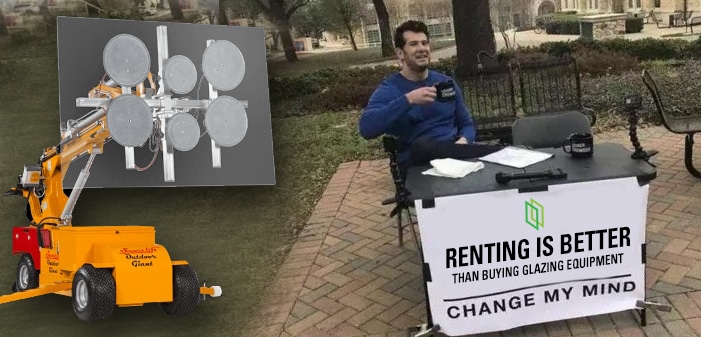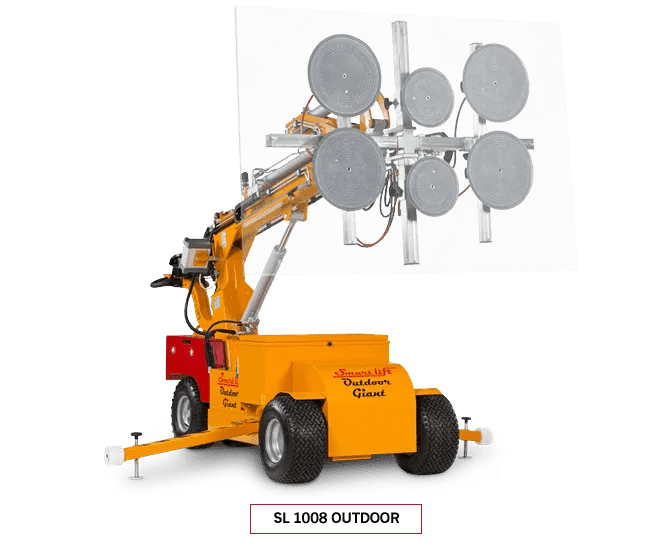Why Renting Equipment For Glazing Projects is Better Than Buying

This article is a companion to our course module on shop glazing. The point of the article is to explain why renting heavy equipment for glazing projects is a better option than buying.
First off, it’s important to note that, for typical projects, glaziers can cut, fabricate, assemble, and install aluminum framing without any equipment. But when shop glazing techniques are used — in other words, when frames are fully assembled in the shop — there you’re going to need heavy equipment at the jobsite to handle the large and heavy frames.
For example, you will almost certainly need a boom or scissor lift. But you’ll also need some more specialized equipment designed for large glazing jobs, such as Great Lakes Lifting Solutions’ SL 1008 Outdoor (pictured below).

While it would without question be awesome to own a slick piece of equipment like the SL 1008 (or even better, the URW 706 Spydercrane), it makes more sense to rent. Read on to learn why.
Most Glazing Projects are Relatively Short
Typical glazing projects last from a few days to a few months — very few projects last for a year or more. And, even if you’re on the jobsite for over a month, you won’t necessarily need access to specialized equipment every day. Glaziers spend a lot of time laying out frames, installing clips and anchors, and various other tasks before the glazed frames can be installed. Then, once the frames are installed, lifting equipment is no longer needed. So the window of time in which you need lifting equipment is really pretty short.
The Equipment Required Often Varies
Another good reason to rent is the variety of equipment you need at different stages to carry out a single job. For instance, you might need a man lift during the layout and clip installation period, or a scissor lift. But when you need to install the frames, you’ll need a smartlift to accomplish the job. Then, once that’s done, you’ll need the manlift again to seal the frames and install outdoor accessories. If you bring all this equipment to the jobsite at once, you’ll end up with a stable of expensive equipment, which becomes a liability and takes up valuable real estate at the jobsite. Plus, not every job will call for the same size lifts and cranes, so if you choose to buy equipment, you might find it’s not always suitable.
Renting Reduces Logistical Problems
There’s also the logistical headache of storing large equipment when you’re not using it and getting it to the jobsite when you do need it. If you rent, you won’t need to worry — it’s fine to leave equipment outside over short periods. But if you own the equipment, you’ll need to find an indoor storage solution. This can be a major challenge for small businesses, especially those in urban areas where space is limited.
Of course, you also have to consider how to get your equipment to the jobsite. But when you rent, you don’t have to worry about that: the rental company will deliver the equipment to your jobsite on time.
Renting gives you the flexibility to choose the best equipment for the job and schedule the machines just for the days you need them. Which brings us to another reason to rent: your budget.
Renting is Cost Effective
Most scissor lifts cost between $10,000 and $15,000, and larger models can go for up to $50,000. A standard 30- or 40-ft boom lift costs between $25,000 and $75,000. But if you need a large boom lift, expect to fork over $100,000 to $200,000!
These are sizable investments for your business, so it’s worth considering the alternative, which is renting equipment on an as-needed basis.
Another factor to consider is maintenance and depreciation. When you rent, you usually get to use modern equipment. Manufacturers are constantly refining their products, making them safer and easier to use, more efficient, and better all around. Rental companies regularly purchase new equipment as their business grows or as old equipment needs to be retired. If you purchase your equipment, however, not only will you have to pay the big upfront cost, but you’ll also have to maintain the equipment and pay for repairs if they stop working. Plus, your investment will be losing value every day as the equipment gets older. The longer you hold onto it, the more value you’ll lose and the more you’ll have to pay to maintain it.
Renting is always a lot easier on your budget. Scissor lifts usually cost between $100 and $150 a day, with weekly rates between $350 and $500. A boom lift will cost you $250 to $400 a day, or $1,000 to $1,500 a week. Some companies also offer monthly rates, which could save you money if you need equipment for a longer job. All in all, that’s a lot fewer zeros.
Renting Gives You Flexibility and Peace of Mind
Hopefully this article convinced you that renting is usually a better choice than buying heavy equipment for glazing jobs. Renting gives you more flexibility to be able to adapt to changes in your business and ongoing projects, ensuring you get the right equipment for the job. It also frees up cash that you can use to invest in other parts of your business or save for a rainy day. Plus, it saves you from the logistical headache of figuring out where to put all your equipment and how to move it around from site to site.
The bottom line is that renting allows you to focus 100% on your glazing jobs, and not on logistical issues that can eat up your time, budget, and your patience!
